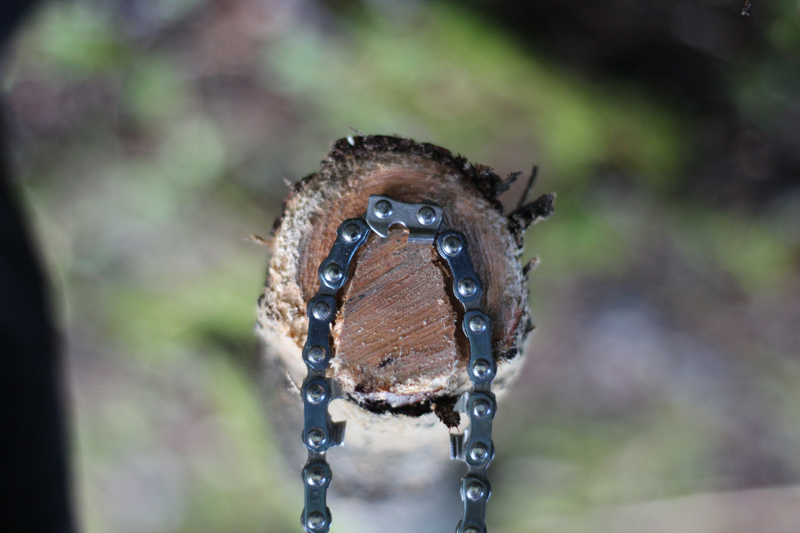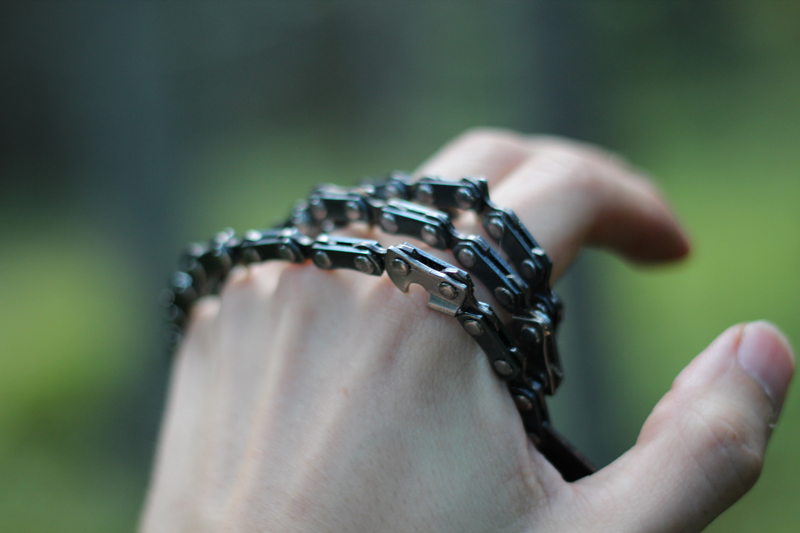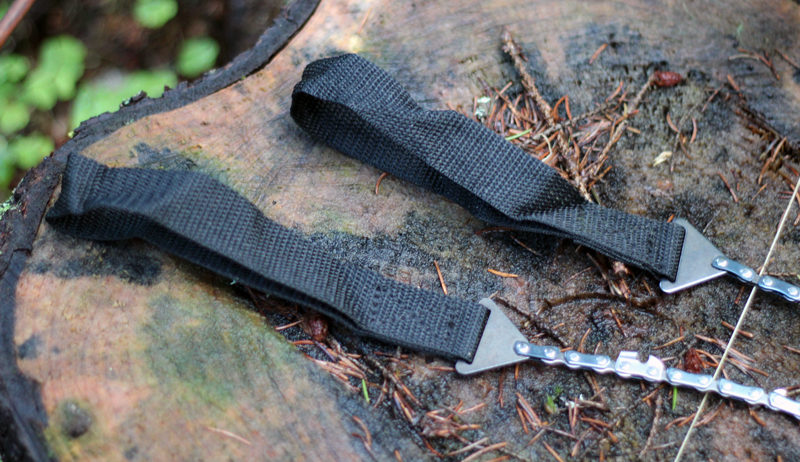The Chainmate 24-inch Survival Pocket Chain Saw is a favorite saw among outdoorsmen, campers, and your average survivalist because of its compact size and above all the affordable price at less than ten bucks.
It has modified carbon steel chainsaw blades similar to what you’ll find on real chainsaws, and in this aspect it’s very similar to the SaberCut saw that I reviewed here.
Did it cut wood like butter as the claims says? Here’s the results:
Performance
It’s like a chainsaw but without the motor, or more accurately with this chainsaw YOU are the motor.
So if you’ve got average strength then this saw should work decently enough for you, but you’ll wear out fast. I sure did.
If you have the required muscle then the Chainmate cuts through wood quickly, no matter if it’s a small branch or a thick log. If you’re two people, one on each side, you can make a quick job of even a decent sized log.
But just as with the SaberCut saw, this saw binds a lot towards the end of cutting through a tree. You can see why in this photo:

As you can see, the further you cut through a piece of wood the tighter the cutting curve gets, and the tighter the curve the easier the saw binds. Yes you can hold the handles apart to get a wider angle, but you lose a lot of strength and will wear out faster.
The issue of binding is the biggest issue I found with this saw but there are two ways to counter it:
- Often when you’ve cut through the wood to the point where it starts to bind you’ll be able to break the wood without further cutting, e.g. snap the branch or push the tree until it breaks.
- When you’re roughly half-way through the wood, flip it over 180 degrees and start cutting from the other direction.
Any of these two methods will allow you to cut through the whole thing, but to be honest I’d rather just have a saw that worked all the way through.
One neat trick that you can do with a saw like the Chainmate though is to cut branches way up in the air. You do this by tying a piece of cord (for example 550 paracord) to each handle and throw one end of the paracord over the branch, get the saw in place and just start cutting. You can easily bring down branches 40 feet up in the air this way. Just watch your head.
There was no noticeable difference in performance compared to the SaberCut saw, but compared to folding and fixed saws the Chainmate loses because of the binding and that you wear out quicker.
Construction Quality
Just as with the SaberCut saw this is a simple build: Two web handles attached with steel clips to a saw chain.

At first glance the carbon steel chain looks nearly identical to the SaberCut chain, but when I looked closer I noticed that the teeth are of lesser quality on the Chainmate saw. Not as uniform and precision-made, but instead rather rough in some places and of varying thickness.

And it was the same with the handles that has thinner material and not as good stitching.
The included pouch with quick-clip buckle was no different. Inferior material and stitching compared to the SaberCut pouch.
The Chainmate saw is made in the US according to the Amazon product description, but I highly doubt it. The higher quality SaberCut saw is made in China, and my guess is that the Chainmate saw is made there as well.
The quality is not all that bad for the price, but there’s a distinct difference to the higher priced SaberCut saw.
Ease of Use – 4
As mentioned in my SaberCut saw review:
To minimize binding in the wood while sawing you need to have a pretty consistent rhythm when you cut. It also helps to hold the handles further apart, but that’s only practical to some degree because you tire quickly.
But this saw will bind in the wood, and when it does it can sometimes be a pain to get unstuck. Especially if you’re felling standing trees that can “lock in” the chain in the cut.
And the other thing that detracts from the ease of use is the amount of energy it takes to use this saw. Because the blade is so thick it takes more force to cut through, and you really feel it in your limbs. To use this saw for any extended amount of time you need muscles. Big ones.
Maintenance – 7
As for sharpening the teeth, yes it’s possible but probably not worth it to buy the required tools when you can buy a new Chainmate saw for under ten bucks.
A tip from survival expert John “Lofty” Wiseman for taking care of the saw and protecting it from rust and breakage is to cover it in a film of grease.
Other than that, there’s not any maintenance to speak of.
Brand Reputation – 2
I’m baffled. The manufacturer of this saw, Chain-Mate Inc., does not seem to exist. I can’t find anything online about this company aside from the brief Amazon product description. Nothing.
What kind of company doesn’t have a website these days? It feels shady, and reflects negatively on their products.
Guarantee – 2
As the manufacturer does not seem to exist I doubt a manufacturers warranty exists. Depending on the retailer you purchase from they might offer a guarantee, but considering the low price it’s probably not worth the hassle of returning it if it breaks.
Sustainability – 4
It’s the same From an environmental standpoint it’s naturally more sustainable than an actual chainsaw both in production and in use, but from a personal standpoint it’s just not a sustainable way of cutting wood. You’ll expend too much energy so it’s not worth the effort.
Self-Reliance – 4
Just as with the SaberCut saw the Chainmate saw is a cool gadget, but it won’t help you become more self-reliant in the long term.
It could potentially be of good use during a survival situation if that’s what you choose to bring with you in a survival kit, or for clearing tricky trees after a storm, but those are about the only good uses I can see for it in terms of self-reliance.
Value – 5
You can get the Chainmate saw for $9.85 on Amazon (back when I bought mine it was $12.03). That’s about four dollars cheaper than the SaberCut saw($13.95).
Is the Chainmate good value at $9.85? Yes, I’d say it is. But at $13.95 the SaberCut saw is even better value because of the higher quality construction and the lifetime guarantee. So if you want to buy a pocket chain saw, I’d recommend you go with the SaberCut saw.
I’ll reiterate what I said in the Sabercut review though. If you add ten bucks to the price of the Chainmate you can get a Bahco Laplander (see our Bahco Laplander review here) and if you add $30 you can get a 21 inch Sven Saw. Both of those are superior value and performance compared to the Chainmate / SaberCut saws, but on the other hand they’re a whole other category of saws that are not quite as compact.
Excitement – 4
The Chainmate Survival Saw can be viewed as a bargain at less than ten bucks. I don’t regret the purchase because it’s a cool tool that might be good to have around one day, but it definitely won’t be my first choice when I need to use a saw.
Specifications
Length (blade): 24 inch (61 cm)
Thickness: 4.5 mm (0.177 inches)
Weight (blade): 4 ounces
Weight (total): 5 ounces
Origin: USA?


